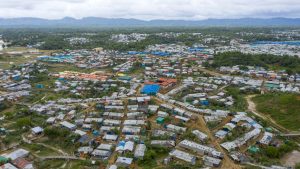The United Nations World Food Programme has again increased its food aid to the Rohingya refugee camps in Bangladesh, the group confirmed this week, offsetting two cuts that were made last year in response to funding shortfalls.
In a report yesterday, BenarNews quoted a WFP spokesperson as saying that the organization’s monthly food allotment had been increased from $10 to $12.50. This comes after a similar increase in January, which saw the monthly food provision for the Rohingya increased from $8 to $10.
The district of Cox’s Bazar is home to around 1 million mostly Rohingya, most of whom were driven out of Myanmar’s Rakhine State during the “clearance operation” launched by the Myanmar military in August 2017 – on operation that U.N. experts said was marked by “genocidal intent.”
Most have remained there in the six years since, confined to a series of refugee camps, semi-permanent warrens of bamboo and tarpaulin dotted around the town of Cox’s Bazar. Over time, with donor attention and resources stretched thin by other international crises, the WFP and other U.N. agencies have faced funding shortfalls that have forced them to tighten their belts.
Last year, the WFP twice cut its daily allotments to the Rohingya refugee camps, from $12 per person per month to just $8, and the U.N. refugee agency UNHCR warned of a “severe funding crisis.” This was one of several factors that contributed to an increased climate of ennui and desperation in the camps, which prompted increasing numbers of Rohingya to undertake dangerous ocean voyages in search of sanctuary abroad, usually in Muslim-majority Malaysia and Indonesia. According to UNHCR figures, the number of Rohingya refugees undertaking these boat journeys to Indonesia and Malaysia jumped 360 percent between 2021 and 2022, when 3,705 embarked from Bangladesh. This then rose to nearly 4,500 last year; of these, 569 were reported deceased or missing, making 2023 the deadliest year in the Andaman Sea since 2015.
The latest hike in the food aid, which reportedly came after lobbying by Bangladeshi government officials, comes as a rare bit of good news for the Rohingya refugees in Bangladesh. However, it also underscores the apparent intractability of the Rohingya refugee crisis in Bangladesh.
UNHCR continues to push for a “dignified and sustainable return” of refugees to Myanmar, but as the International Crisis Group (ICG) stated in a report earlier this year, the prospect of this happening any time soon is slim. Since the military coup of 2021, the security situation in Rakhine State has deteriorated markedly, and six years on, “the almost one million Rohingya refugees in Bangladesh are no closer to returning home.”
The ICG report was published in December, at the beginning of a major offensive by the Arakan Army (AA), a Buddhist Rakhine ethnic armed group that has since seized large swathes of Rakhine State from the military junta’s control. This has further complicated the situation. As the AA has battled for control of northern Rakhine State, its forces have been accused of razing Rohingya villages and displacing thousands of civilians. After seizing the town of Buthidaung in mid-May, Human Rights Watch reported this week, the AA’s forces “shelled, looted, and burned Rohingya neighborhoods in Buthidaung town and nearby villages, causing thousands of Rohingya to flee.” (Junta forces also reportedly carried out similar attacks on Rohingya villages prior to withdrawing.)
This has been followed by similar claims as the AA has moved westward toward Maungdaw, which sits across the Naf River from Bangladesh. Particular scrutiny has attached to a suspected drone attack on Rohingya seeking to flee Myanmar that killed “many dozens of people, including families with children,” according to a Reuters report published on August 12.
Many Rohingya activists and eyewitnesses have accused the AA of carrying out the attack, though as with the incidents in Buthidaung, the group has denied any involvement, pinning the blame on the junta. (Unsurprisingly, the latter has also accused the AA of responsibility.) At the same time, the AA and Rakhine nationalist news sites have stated that the group has undertaken efforts to rid the town of “Muslim extremists” working with the military, a seeming reference to Rohingya militant groups and Rohingya who have been forcibly conscripted into the Myanmar military. The Reuters report concluded that it “could not verify how many people had died in the attack or independently determine responsibility.”
In any event, the growing attacks on the Rohingya population of Buthidaung and Maungdaw, many of whom narrowly escaped falling victim to the military’s ruthless “clearance operation,” have prompted the largest flight of civilians across the Naf River since 2017. BenarNews quoted one camp leader as estimating that thousands had arrived in recent weeks after fleeing violence in Rakhine State. A subsequent report by the news agency stated that “more than 13,000 Rohingya Muslims” had fled their homes in Maungdaw to escape the fighting between the AA and the military.

































